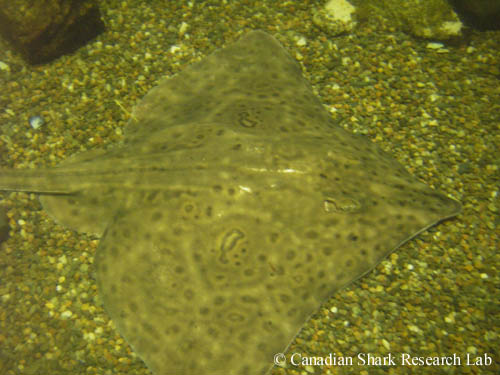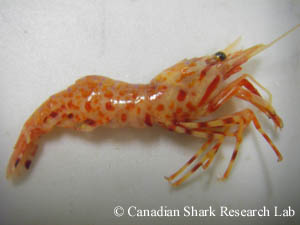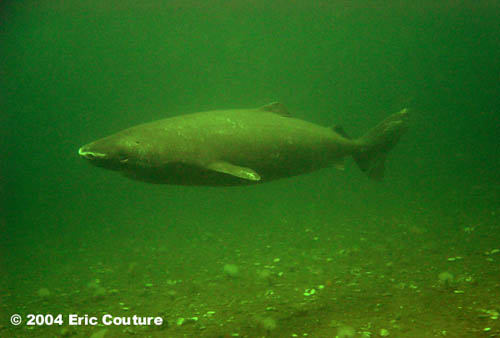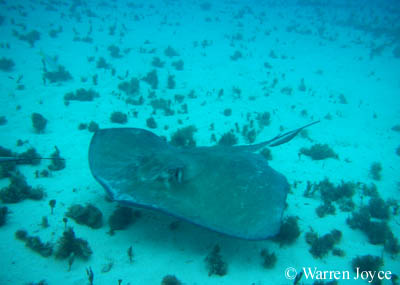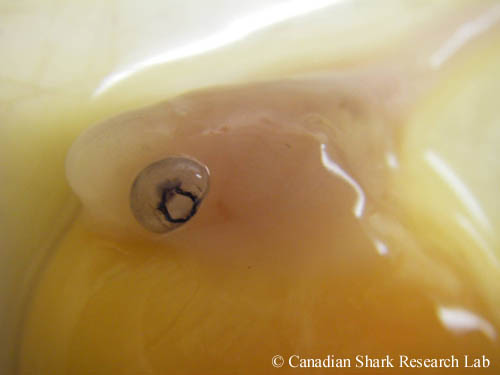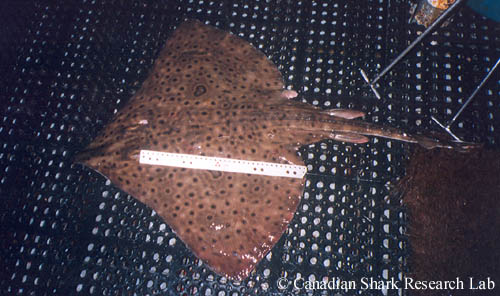Skates and rays general information
There are over 500 species of skates and rays in the world, with 16-17 species residing either as year-round residents or occasional visitors in Atlantic Canada waters. Skates and rays are easily distinguished from other fish by their disc-shaped, dorso-ventrally (i.e. from top to bottom) flattened bodies and expanded pectoral fins which attach to the sides of the head. This basic body shape allows them to live on or very close to the bottom of the ocean, where they bury themselves in mud or sand to ambush prey and avoid predators. However, a number of species, such as members of the family Myliobatidae, have become nektonic, using their enlarged pectoral fins to literally "fly" through the water.
Along with their basic body shape, skates and rays are characterized by ventral gill openings, eyes and spiracles located on the top of the head, pavement-like teeth, and lack of an anal fin. Unique adaptations of certain species include specialized electric organs capable of producing a painful electric charge (electric rays) and modified placoid scales - or barbs - capable of giving a piercing sting (stingrays).
Despite this diversity, however, skates and rays - collectively known as batoids - are a little-known group. Even the most basic life history information is lacking for most species, including those residing in Atlantic Canada waters. For example, we know little about how old skates and rays get, when they mature, whether they have nursery grounds, how far they migrate, and how vulnerable they are to over-exploitation. And unfortunately, with species-specific data on batoids being virtually non-existent in most cases, many species are declining in abundance as their importance in directed and bycatch fisheries increases.
This website was created in the hopes of increasing public awareness about these fascinating and underappreciated marine fishes. Many questions concerning basic batoid biology can be answered using this website, along with more detailed questions concerning northwest Atlantic species. Also covered are some of the research initiatives being undertaken by scientists at the Canadian Shark Research Lab at the Bedford Institute of Oceanography and at the Marine Fish Species at Risk Section at the Northwest Atlantic Fisheries Center to better understand the biology, abundance, and population health of skates and rays in Atlantic Canada waters, so that these enigmatic fishes remain a vital part of our ocean ecosystem.
Skate tagging

Small and large skate tags with location of serial number indicated.
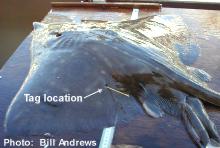
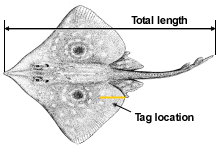
In March 2003, an extensive tagging program for big skate (Raja binoculata) was initiated by DFO. The objective of the study is to quantify seasonal migration patterns of big skate and to provide information on growth to augment age determination research.
Tagging surveys have occurred in March and August 2003, March 2004, March 2005, March 2006, August 2006, and February 2008. We have used both the research vessel CCGS W.E. RICKER and the commercial vessel the F/V FROSTI to conduct these surveys. Between 2003 and 2006, 17,100 skate were been tagged in Queen Charlotte Sound, northern Hecate Strait, and Dixon Entrance. In 2008, about 1400 skate were tagged off the west coast of Vancouver Island.
Skates are tagged in their left wing, using one of the following types of tags:
- yellow or red plastic "spaghetti" tags on skates < 100 cm
- Hallprint PDS (small plastic dart anchor) tags on skates up to 80cm long
- Hallprint PDA (plastic dart anchor) tags on skates 80-100 cm long
- a larger yellow, orange, or red metal-anchor "spaghetti" tag from Floy Tag on skates more than 100 cm long
Anyone finding a tagged skate is requested to note the tag serial number, along with date, location, and method of capture, and the total length of the skate. This information, along with the tag, can be passed on to one of the contact persons below. A reward hat will be provided for each skate tag returned, or alternatively, a reward vest will be provided for each group of five skate tags returned.
As of May 2013, 1847 tags have been returned to the Pacific Biological Station. The furthest ranging skate so far was captured in the Aleutian Islands, 2340 km from where it was tagged.
Send tag and information to
Maria Surry
Fisheries and Oceans Canada
Pacific Biological Station
3190 Hammond Bay Road
Nanaimo, BC V9T 6N7
Tel: 250-756-7317
Schon Acheson
Senior Groundfish Port Sampler
Unit # 3
100 Annacis Parkway
Delta, BC V3M 6A2
604-666-2658
Feeding
How do skates and rays feed?
Skates and rays primarily feed in or on the ocean floor by biting off pieces of sessile invertebrates or excavating buried prey, although they will also feed in the water column. Methods used by skates and rays to excavate buried prey include "wing-flapping" or movement of the pectoral fins to stir up the bottom sediment; hydraulic mining, whereby repeated jaw opening and closing generates water flow in and out of the buccal cavity and resuspends food and sand; and lastly, suction. The jaws of skates and rays are only loosely connected to the cranium, a development which allows these fish to protrude their jaws a short distance from their heads when feeding. This action, in turn, creates suction for picking or pulling prey off the bottom, along with sediment. The later is ejected out of the mouth, spiracles, or gill slits once the food is separated from the sediment in the mouth.
The typical predatory technique employed by skates and rays is that of ambush. Ambushing involves the predator either concealing itself or advertising its presence through aggressive mimicry while lying in wait for its prey. Skates and rays - especially larger species and older individuals - commonly bury themselves either entirely or partially in the soft substrate of the ocean floor in order to catch their demersal prey by surprise.
What do skates eat?
Skates (Family Rajidae) of the northwest Atlantic are carnivorous "generalists". In other words, each species typically consumes a variety of organisms ranging from crustaceans such as crabs, shrimps, lobsters, amphipods, isopods, and mysids, to polychaete worms, bivalve mollusks, small fishes and occasionally cephalopods. Their diet is slightly ontogenetic, with larger, older individuals consuming more fish and cephalopods (i.e. benthopelagic food items) and fewer infauna and epifauna (i.e. benthivorous food items) than juveniles and adolescents.
What animals eat skates and rays?
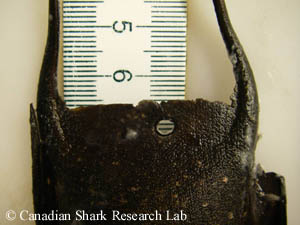
A thorny skate (Amblyraja radiata) egg capsule collected off the sea floor and showing a distinct bore hole
Skates and rays are preyed upon by many different organisms. Prior to hatching, energy-rich skate eggs are preyed upon primarily by gastropods, but are also consumed by marine mammals such as seals and sea lions. There have also been skate eggs found in sperm whales. However, given the large size of sperm whales, it is more likely that the sperm whales either accidentally picked them up off the sea-bottom when pursuing other prey, or ingested the eggs with a gravid female. Studies on egg capsules of the thorny skate (Raja radiata) (known in Europe as the starry ray) off the Danish coast found that as many as 18% had bore holes apparently created by carnivorous gastropods. Similarly, eggs of little skate (Leucoraja erinacea) experimentally incubated for a year in waters off the coast of Maine showed a 22% frequency of boring, and multiple boring into a single prey capsule was fairly constant. As of yet though, the population and evolutionary effects of egg predation skate species can only be speculated upon.
After hatching, skates are eaten by many predators, such as sharks, other skates and rays, and grey seals. However, since elasmobranchs lack bone and otoliths, hard remains of these fish are rarely found in stomach contents or feces of their predators, making accurate predictions of predation rates difficult to obtain. Occasionally though, dermal scutes of skates have been recorded in seal feces in the UK.
In more tropical environments, great hammerhead sharks, Sphyrna mokarran, have been observed capturing and consuming rays. Specifically, they use their distinctly-shaped heads to both deliver powerful blows to rays and to restrain them on the substrate prior to biting pieces off of them. Another predatory behavior carried out by hammerheads feeding on rays is called"pin and pivot" behavior, whereby the shark forcibly presses the ray against the bottom with the ventral surface of its cephalophoil and then, while remaining atop the ray, twists its body and pivots its head to engulf part or all of the ray.
Reproduction
Reproductive Strategies
As with all elasmobranchs, skate and rays are internal fertilizers. Internal fertilization is beneficial because it increases the likelihood and efficiency of fertilization by reducing sperm wastage. In addition, it ensures that the energy-rich eggs produced by the female are not consumed by predators, and that all the energy allocated to reproduction is passed to the embryos and not lost to the environment. This is especially the case for species that retain their embryos until the embryos have completely developed, a reproductive mode termed viviparity. Elasmobranches that practice viviparity are called viviparous (or live-bearing). There are many types of viviparity, which can be divided into two broad categories: aplacental and placental viviparity. Placental viviparity is the most advanced mode of reproduction, during which the embryos are initially dependent on stored yolk but are later nourished directly by the mother through a placental connection. This type of reproduction is not exhibited by any type of batoid. Ovoviviparity (or aplacental viviparity), on the other hand, is the only mode of reproduction employed by rays. In rays, the embryos rely on the substantial yolk within the ovulated egg only during the initial stages of development. After the nutrients stored in the egg have been consumed, the embryo ingests or absorbs an organically rich histotroph (or "uterine milk") produced by the mother and secreted into uterus. The most highly developed of these strategies occurs in some rays in which the lining of the uterus forms tiny, finger-like projections (termed trophonemata) that increase the surface area for histotroph secretion. This form of nutrient supply (or maternal investment) results in very large offspring, which is characteristic of most species of ray.
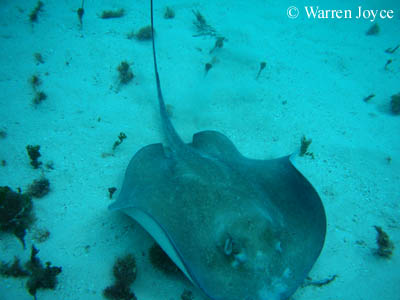
A southern stingray (Dasyatis americana). Stingrays - as with all rays - are ovoviviparous, bearing live young. When the yolk sac is absorbed, nourishment is provided through "uterine milk" from the mother.
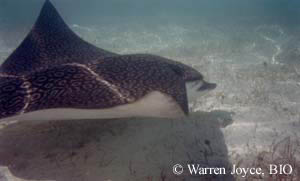
A spotted eagle ray (Aetobatus narinari). All rays are ovoviviparous, bearing live young.
Other elasmobranchs retain their eggs for shorter periods of time and then deposit them on the ocean floor in tough, keratinized egg cases, a reproductive mode termed oviparity. These elasmobranchs are called oviparous (or egg-laying).
The young of both oviparous and viviparous forms hatch, or are born, as fully developed, miniature copies of their parents that are capable of actively avoiding predators, unlike the larval stages of many teleost fishes. The relatively large size reached by all elasmobranchs prior to hatching, or birth, also ensures that they are capable of consuming a wider variety of potential prey.
All skates exhibit the most primitive form of oviparity, termed extended oviparity. Extended oviparity is a mode of egg-laying where embryonic development occurs primarily outside of the mother, and can last for very long periods of time. More specifically, the energy-rich ova are fertilized within the oviducts; quickly encapsulated in keratinoid egg cases secreted by the shell (or nidamental) glands; and then deposited on the substrate sequentially in pairs of two. Once the egg cases are deposited on the bottom (termed oviposition), the embryos receive no further parental care, and are nourished solely from yolk stored in the yolk sac. The tough egg case provides an osmotically independent environment until the embryo is capable of urea retention and osmoregulation. It also forms the only protective barrier against predators and the outside environment that the embryo has. Development within the egg case is a slow process that can last for a period of up to 15 months, after which the embryo (or miniature skate) pushes its way out of the capsule. Approximately 42% of living chondrichthyans (or cartilaginous fishes) have extended oviparity.
Oviparity is thought to be the more primitive or ancestral condition in elasmobranchs. A gradual evolutionary shift from oviparity to viviparity in some species may have served to better shield young against potential predators and other hazards, as well as to offer a more uniform developmental environment. The young of oviparous elasmobranchs also tend to be smaller than those of viviparous elasmobranchs because the amount of nutrients available to the developing embryo is limited to what is stored in the yolk sac. Larger young, in turn, are better able to avoid predators, perhaps explaining an overall evolutionary shift away from oviparity, especially in more pelagic species.
Although oviparous species provide no parental care in the form of nutrients after the egg is deposited, little is known about "parental care" in oviparous elasmobranchs. None are known to actively guard their eggs or build nests, but it is possibel that egg-laying elasmobranchs select appropriate substrate for their eggs so as to maximize the chances of survival of the developing embryos. The females of at least one species of bullhead shark (family Heterodontidae) are known to pick up their eggs in their mouths and then wedge them into rocks and marine vegetation.
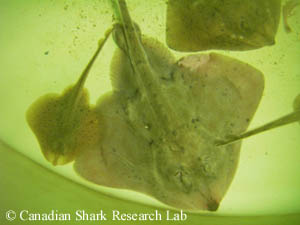
Northwest Atlantic skates in a holding tank at BIO. Skates are oviparous, laying tough egg cases (also called "mermaids purses") on the seafloor from which miniature skates hatch.

A newly hatched thorny skate (Amblyraja radiata). Note the swelling of the body cavity, indicating the presence of an internal yolk sac.
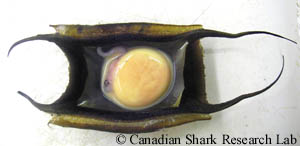
The egg capsule of a thorny skate (Amblyraja radiata), with one wall cut away to reveal a developing embryo
Mating
Mating behaviour has been observed in the wild in very few species of elasmobranch. Only five of the more than 450 species of batoids have been observed copulating in the wild, leaving most aspects of their natural sexual behaviour unknown. Female receptivity to copulation likely depends on hormonal status. Behavioural and/or chemical cues may then signal this receptivity to the males. For example, the process of parturition might produce some form of sexual pheromone or olfactory attractant for male rays. Precopulatory mating behaviour (i.e. grasping and biting by the males) occurs in many species of elasmobranch - including many species of batoid - and is evident in scars and wounds on the females. For example, male eagle rays (Aetobatis narinari) dive upon and gouge the back of females during courtship, and the copulatory bites of the male roughtail stingray (Dasyatis centroura), round stingray (Urolophus halleri) and the bullseye stingray (Urolophus concentricus) - among others - can inflict lasting scars on the female. Mating and insemination is often a long, drawn-out process, especially in batoids, where copulation can last for several hours. In some species of elasmobranch, sperm are then stored in the nidamental gland of the female, in some cases for months or longer, before they are released to fertilize ovulated ova.
Skate fisheries
Skate Fisheries
Many species of skates are rays are becoming increasingly important in fisheries around the world. Skates, for example, have edible "wings", the flesh of which is firm, white, sweet and similar in texture and taste to that of scallops. In the eastern Atlantic , skate meat is esteemed, and skate wings are eaten fresh, salted, or smoked. In the northwest (NW) Atlantic, on the other hand, skates were fished primarily for use in fish meal and pet food, and occasionally in the preparation of imitation scallops, until declines in traditional groundfish species - such as Atlantic cod (Gadus morhua) - brought about an increase in "alternative" fisheries. Today, NW Atlantic skates are considered quality food items, with commercial fisheries aimed primarily at winter skate (Leucoraja ocellata) and thorny skate (Amblyraja radiata). These two species are caught with longlines, gillnets, and trawls, and their large pectoral fins are commercially marketed up and down the coast of North America as well as overseas in Europe.
Brief Background of Atlantic Canada Skate Fisheries
- Traditionally, skates (mostly thorny and winter) were landed by foreign fleets throughout the NW Atlantic until the implementation of the 200-mile limit in 1976, after which skates in Canadian waters were taken only as bycatch and mostly discarded.
- Domestic fleets began targeting skate in inshore waters in 1994 when - in response to the collapse of the major groundfish fisheries - the Canadian Department of Fisheries and Oceans (DFO) established an experimental skate fishery on the southwestern Grand Banks , southern St. Pierre Bank, and the adjacent Scotian Shelf.
- A regulated skate fishery was then established in 1995 by Canada inside the 200-mile limit. Winter skate was the primary focus of the commercial fishery on the eastern Scotian Shelf, constituting greater than 90% of the catch, whereas thorny skate was the targeted species in NewFoundland waters.
- Since the institution of this non-traditional fishery in Canada , the total number of fishing vessels actively fishing skate (mainly thorny skate) on the Grand Banks has gradually increased. However, the total reported catch including discards in 2005 for that region was lower than in previous years.
- Landings by the Canadian skate fishery (mainly winter skate) on the Scotian Shelf have been progressively lower since 1994, reflecting reductions in total allowable catch (TAC). More specifically, landings fell from 2000 t in the first year to less than 300 t annually since 2001.
- In 1995, following the designation of the winter skate on the eastern Scotian Shelf as threatened by the Committee on the Status of Endangered Wildlife in Canada (COSEWIS), the directed fishery on the eastern Scotian Shelf was abandoned.
- Directed fishing on the Grand Banks continues, as does fishing for skate in other areas of the NW Atlantic, such as Southern New England.
Bycatch
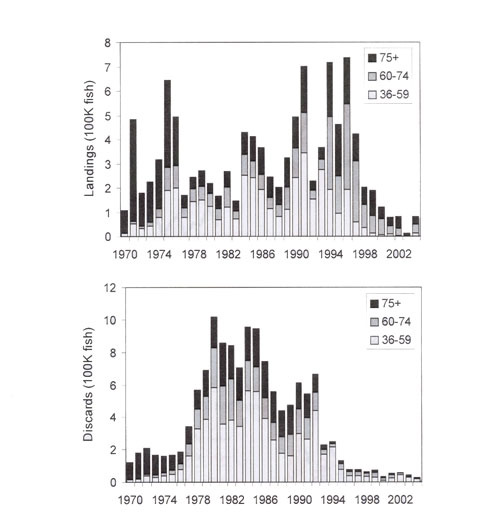
Estimated total landings and discards of winter skate (Leucoraja ocellata) on the eastern Scotian Shelf (NAFO Divisions 4VW) by size class (cm) from 1970 to 2004. Figure from Recovery potential assessment of 4T and 4VW winter skate (Leucoraja ocellata): biology, current status and threats. 2006 (CSAS resdocs - 2006/003). D.P. Swain, J.E. Simon, L.E. Harris, and H.P. Benoit. CSAS 2006/003
Unfortunately, along with capture in directed fisheries, NW skates have and continue to be subjected to enhanced mortality through indirect fishing pressure. Skates are caught unintentionally (i.e. as"bycatch") by groundfish trawling and scallop fishing operations and either kept (i.e. "landed") or discarded. Annual discards of skates have fluctuated in most areas, although in some areas such as the northeast coast of the US, the biomass of total discards was estimated to be two to eight times the reported landings (1989-1998). It is currently not known whether the skates that are discarded survive, and if so, how many. Moreover, in Canada, skate landings are not consistently identified by species, but are instead classified as "skates unspecified", making it difficult to access the status of each skate species separately. Recent studies on skate abundance in the NW Atlantic from research vessel surveys suggest that fishing pressure - along with other sources of mortality - is causing the collapse of many species. For example, on the eastern Scotian Shelf, winter, thorny and smooth skate (Malacoraja senta) adult abundance appears to have declined by more than 90% since the 1970s. For more information on the current status of skates in Atlantic Canada waters, go to the Skate Conservation section of this website. Documents such as stock status reports and research documents - including the Recovery Potential Assessment (RAP) documents for winter skate - are available through the Canadian Science Advisory Secretariat.
Worldwide
Along with captures in the eastern and western North Atlantic Ocean, rays and skates are captured in large numbers by artisanal and commercial fisheries operating in the southern Atlantic, Pacific and Indian Oceans. In the Indo-West Pacific in particular, batoids are facing heavy directed and bycatch fishing pressure over most of their range due to their valuable fins. For example, many species in the third largest batoid family - the whiptail stingrays (Dasyatidae) - are declining dramatically in number due to intensive inshore fishing pressure in Indonesia and other parts of Southeast Asia. Unfortunately, unless fishing pressure on batoids is reduced, we may see localized extirpations and even extinctions of some species.
- Date modified:

